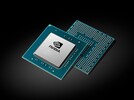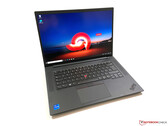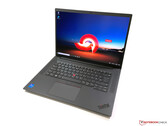
Lenovo ThinkPad P15v G2 laptop review: Affordable business workstation
Intel Core i7-11800H | NVIDIA T1200 Laptop GPU | 15.60" | 2.3 kg

The Nvidia T1200 Laptop GPU (or Quadro T1200 for laptops) is a professional mobile graphics card that is based on the Turing architecture (TU117 chip). Compared to the consumer GTX 1650 Ti, the T1200 features more CUDA cores / shaders (1024 versus 896). The Quadro T2000 uses the same TU117 chip, but features all 1024 cores (2x to the T1000) and is therefore significantly faster. The chip is manufactured in 12nm FinFET at TSMC. The T1200 was introduced as a refresh to the Quadro T1000 together with the new Ampere RTX A workstation cards like the faster Nvidia RTX A2000.
It is available in different variants from 35 - 95 Watt (TGP) with different clock speeds (and performance). The GPU supports DisplayPort 1.4 and HDMI 2.1 for external connections.
There is no more Max-Q variant (formerly used for the low power variants) but every OEM can choose to implement Max-Q 3.0 technologies (Dynamic Boost, WhisperMode).
The Turing generation did not only introduce raytracing for the RTX cards, but also optimized the architecture of the cores and caches. According to Nvidia the CUDA cores offer now a concurrent execution of floating point and integer operations for increased performance in compute-heavy workloads of modern games.
Furthermore, the caches were reworked (new unified memory architecture with twice the cache compared to Pascal). This leads to up to 50% more instructions per clock and a 40% more power efficient usage compared to Pascal. In contrary to the faster Quadro RTX cards, the T1000 and T2000 do not feature raytracing and Tensor cores.
When configured as a slow 35W variant, the T1200 is also suited for thin and light laptops.
Quadro Turing Series
| ||||||||||||||||||||||||||||||||||||||||||||||||||||
| Architecture | Turing | |||||||||||||||||||||||||||||||||||||||||||||||||||
| Pipelines | 1024 - unified | |||||||||||||||||||||||||||||||||||||||||||||||||||
| TMUs | 64 | |||||||||||||||||||||||||||||||||||||||||||||||||||
| ROPs | 32 | |||||||||||||||||||||||||||||||||||||||||||||||||||
| Tensor / AI Cores | 64 | |||||||||||||||||||||||||||||||||||||||||||||||||||
| Core Speed | 855 - 1425 (Boost) MHz | |||||||||||||||||||||||||||||||||||||||||||||||||||
| Memory Speed | 10000 MHz | |||||||||||||||||||||||||||||||||||||||||||||||||||
| Memory Bus Width | 128 Bit | |||||||||||||||||||||||||||||||||||||||||||||||||||
| Memory Type | GDDR6 | |||||||||||||||||||||||||||||||||||||||||||||||||||
| Max. Amount of Memory | 4 GB | |||||||||||||||||||||||||||||||||||||||||||||||||||
| Shared Memory | no | |||||||||||||||||||||||||||||||||||||||||||||||||||
| Memory Bandwidth | 192 GB/s | |||||||||||||||||||||||||||||||||||||||||||||||||||
| API | DirectX 12_1, OpenGL 4.6 | |||||||||||||||||||||||||||||||||||||||||||||||||||
| Power Consumption | 95 Watt (35 - 95 Watt TGP) | |||||||||||||||||||||||||||||||||||||||||||||||||||
| technology | 12 nm | |||||||||||||||||||||||||||||||||||||||||||||||||||
| PCIe | 4.0 | |||||||||||||||||||||||||||||||||||||||||||||||||||
| Displays | HDMI 2.1, DisplayPort 1.4 | |||||||||||||||||||||||||||||||||||||||||||||||||||
| Features | 3.7 TFLOPS SP max. performance, DisplayPort 1.4, HDMI 2.1, PCIe 4.0 x8, 192 GB/s memory bandwidth, Max-Q Technologies 3.0 optional | |||||||||||||||||||||||||||||||||||||||||||||||||||
| Notebook Size | medium sized | |||||||||||||||||||||||||||||||||||||||||||||||||||
| Date of Announcement | 12.04.2021 | |||||||||||||||||||||||||||||||||||||||||||||||||||
| Link to Manufacturer Page | www.nvidia.com | |||||||||||||||||||||||||||||||||||||||||||||||||||
The following benchmarks stem from our benchmarks of review laptops. The performance depends on the used graphics memory, clock rate, processor, system settings, drivers, and operating systems. So the results don't have to be representative for all laptops with this GPU. For detailed information on the benchmark results, click on the fps number.

























| low | med. | high | ultra | QHD | 4K | |
|---|---|---|---|---|---|---|
| Vampire Bloodhunt | 121.8 | 72.9 | 69.9 | 69.5 | ||
| Ghostwire Tokyo | 50.7 | 47.3 | 44.6 | 41.2 | ||
| Elex 2 | 43.1 | 39.3 | 34.2 | 29.6 | ||
| GRID Legends | 103 | 73 | 61.7 | 45.7 | ||
| Elden Ring | 52.9 | 47 | 39.5 | 36.8 | ||
| Dying Light 2 | 36.1 | 25.7 | 21.2 | |||
| Farming Simulator 22 | 171.9 | 96.6 | 70.1 | 61.2 | ||
| Riders Republic | 93 | 50 | 41 | 40 | ||
| Far Cry 6 | 86 | 58 | 54 | 47 | 26 | |
| FIFA 22 | 175 | 121 | 119 | 111 | 76 | |
| F1 2021 | 164 | 106 | 89.5 | 53.6 | 39 | |
| Resident Evil Village | 114.3 | 64.3 | 57.9 | 49.8 | ||
| Cyberpunk 2077 1.0 | 61 | 33 | 27 | 22 | 14 | |
| Immortals Fenyx Rising | 84 | 55 | 44 | 40 | 26 | |
| Assassin´s Creed Valhalla | 77 | 47 | 28 | 21 | 18 | |
| Dirt 5 | 125 | 56 | 45 | 12 | ||
| Watch Dogs Legion | 66 | 54 | 47 | 19 | 12 | |
| Mafia Definitive Edition | 84 | 43.4 | 39.2 | |||
| Horizon Zero Dawn | 88 | 60 | 50 | 43 | 32 | |
| Death Stranding | 86 | 68 | 61 | 59 | 40 | |
| F1 2020 | 222 | 109 | 90 | 63 | 45 | |
| Gears Tactics | 268 | 101 | 66 | 46 | 32 | |
| Borderlands 3 | 99 | 62 | 43 | 33 | 23 | |
| Shadow of the Tomb Raider | 96 | 59 | 48 | 39 | ||
| Strange Brigade | 213 | 89 | 73 | 63 | 47 | |
| Far Cry 5 | 109 | 65 | 59 | 56 | 41 | |
| X-Plane 11.11 | 103 | 86 | 69 | 52.4 | ||
| Final Fantasy XV Benchmark | 98 | 54 | 37 | 26 | ||
| Dota 2 Reborn | 148 | 129 | 117 | 108 | 109 | |
| The Witcher 3 | 197 | 126 | 67 | 36 | ||
| GTA V | 168 | 155 | 92 | 50 | 37.4 | |
| BioShock Infinite | 352.2 | 235.8 | 207.9 | 88.1 | ||
| low | med. | high | ultra | QHD | 4K | < 30 fps < 60 fps < 120 fps ≥ 120 fps | 4 16 12 | 1 13 13 5 | 3 15 13 1 | 5 16 7 | 7 8 1 | 1 1 |
For more games that might be playable and a list of all games and graphics cards visit our Gaming List



Lenovo ThinkPad P15v G3, i7-12700H T1200: Intel Core i7-12700H, 15.60", 2.2 kg
External Review » Lenovo ThinkPad P15v G3, i7-12700H T1200
Acer ConceptD 3 Ezel Pro CC315-73P-73QS: Intel Core i7-11800H, 15.60", 2.2 kg
External Review » Acer ConceptD 3 Ezel Pro CC315-73P-73QS
HP ZBook Power G8, i9-11950H T1200: Intel Core i9-11950H, 15.60", 1.9 kg
External Review » HP ZBook Power G8, i9-11950H T1200
Lenovo ThinkPad P15v G2 21A9000XGE: Intel Core i7-11800H, 15.60", 2.3 kg
» Lenovo ThinkPad P15v G2 review: Affordable 15-inch workstation made better with Intel Core i9 and 4K display?
Lenovo ThinkPad P1 G4-20Y30017GE: Intel Core i7-11800H, 16.00", 1.8 kg
» Customers are left in the dark: Only vapor-chamber models of the Lenovo ThinkPad P1 G4/X1 Extreme G4 offer full CPU performance
» Comparison of GPUs
Detailed list of all laptop GPUs sorted by class and performance.
» Benchmark List
Sort and restrict laptop GPUs based on performance in synthetic benchmarks.
» Notebook Gaming List
Playable games for each graphics card and their average FPS results.
Top 10 Laptops
Multimedia, Budget Multimedia, Gaming, Budget Gaming, Lightweight Gaming, Business, Budget Office, Workstation, Subnotebooks, Ultrabooks, Chromebooks
under 300 USD/Euros, under 500 USD/Euros, 1,000 USD/Euros, for University Students, Best Displays
Top 10 Smartphones
Smartphones, Phablets, ≤6-inch, Camera Smartphones